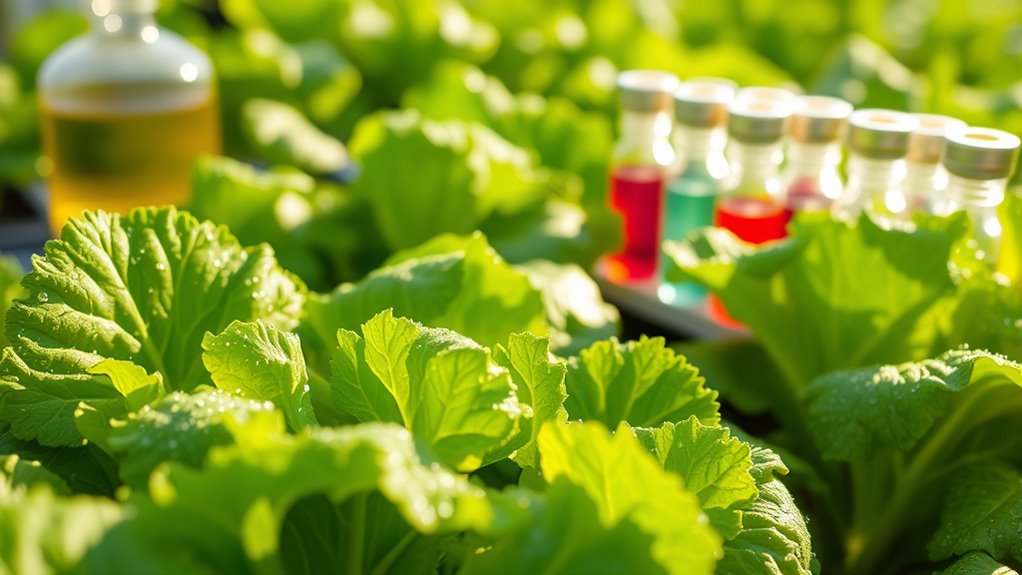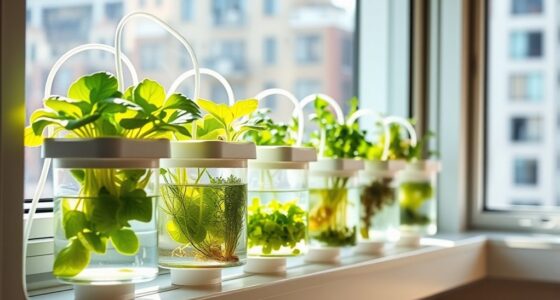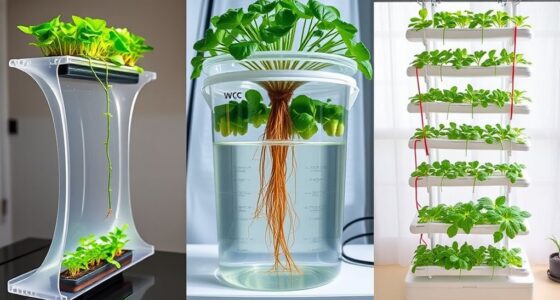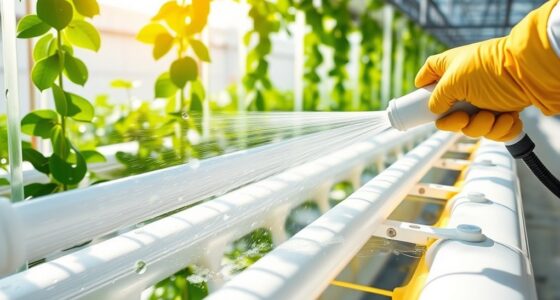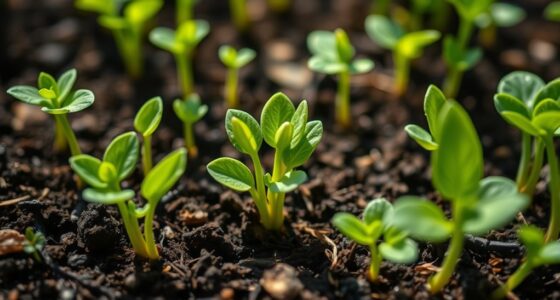Beyond basic NPK, understanding micronutrients is key for thriving hydroponic plants. These trace elements, like iron, zinc, and manganese, are essential for healthy growth but need proper management to stay soluble and available. Chelated forms help prevent precipitation, and maintaining the right pH ensures nutrient uptake. Monitoring levels and adjusting as needed keeps plants healthy and productive. If you keep exploring, you’ll uncover how to optimize micronutrient use for better yields.
Key Takeaways
- Micronutrients are vital in hydroponics for plant health, growth, and maximizing yields, despite needing smaller quantities than macronutrients.
- Ensuring micronutrients are fully dissolved and bioavailable is essential, as poor solubility leads to deficiencies even if nutrients are present.
- Chelated forms of micronutrients prevent precipitation, maintaining their solubility and bioavailability in hydroponic nutrient solutions.
- pH management is critical, as it influences micronutrient solubility; for example, high pH can cause iron deficiency.
- Regular testing and careful nutrient management help sustain balanced micronutrient levels, promoting healthy plant development.
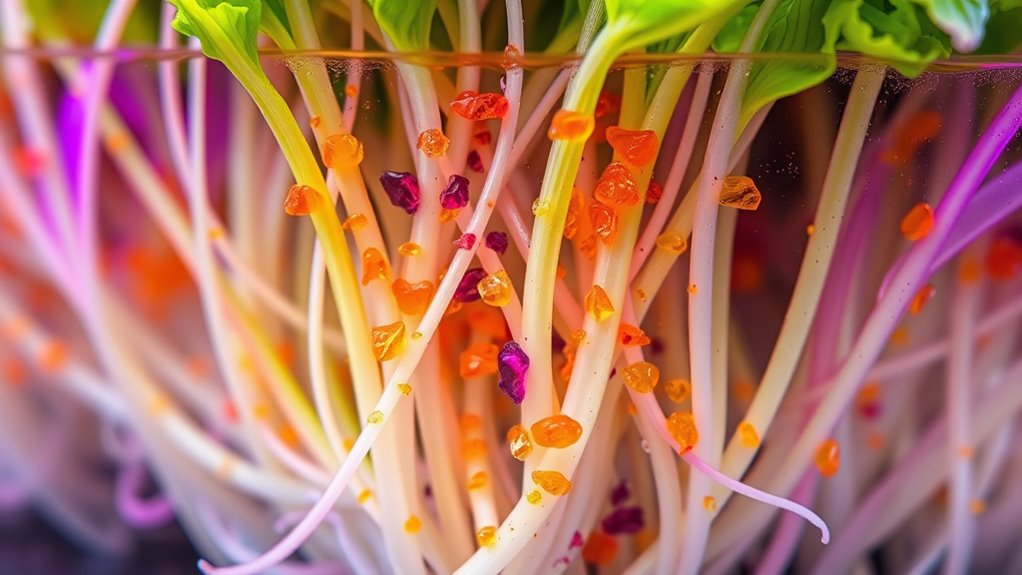
Micronutrients play a pivotal role in the health and growth of plants in hydroponic systems, even though they are required in much smaller amounts than macronutrients. Unlike soil-based gardening, where natural processes like soil mineralization help release nutrients, hydroponic setups rely heavily on dissolved nutrients for plant uptake. Soil mineralization involves the breakdown of organic matter, releasing essential micronutrients into the soil. While this process naturally supplies nutrients in traditional soil systems, it doesn’t occur in hydroponic environments, making nutrient solubility a key factor. You need to guarantee that micronutrients are fully dissolved in the nutrient solution so plants can absorb them efficiently. Poor solubility can lead to deficiencies, even if the nutrients are present in the system, because they aren’t available in a form that plants can uptake. Additionally, understanding the chemistry of nutrient solutions is crucial to maintaining proper micronutrient balance and solubility.
Micronutrient solubility is essential for plant absorption in hydroponics to prevent deficiencies.
In hydroponics, maintaining proper nutrient solubility is essential. For example, micronutrients like iron, manganese, zinc, copper, molybdenum, and boron must be kept in forms that stay dissolved in water. If they precipitate or bind with other compounds, they become insoluble and unavailable to your plants. This is why using chelated forms of micronutrients is common—these compounds prevent precipitation and keep the nutrients in a soluble state, ensuring consistent availability. You also need to pay attention to your pH levels, as they influence nutrient solubility. For instance, iron becomes less soluble in alkaline conditions, risking deficiency unless you adjust the pH accordingly.
Since soil mineralization doesn’t occur in hydroponics, you must supply micronutrients directly through your nutrient solution. Regular testing helps monitor nutrient levels and pH, allowing you to make adjustments before deficiencies develop. When preparing your nutrient mix, use high-quality, chelated micronutrients to maximize solubility and bioavailability. It’s also important to avoid oversupplying micronutrients, as excess can lead to toxicity or interfere with the uptake of other nutrients. Proper management ensures that each micronutrient remains in balance, supporting excellent plant growth.
Understanding these differences between soil and hydroponic systems highlights why controlling nutrient solubility is so paramount. Unlike soil-based gardening, where natural processes assist in nutrient release, hydroponics puts the onus on you to maintain dissolved, plant-available nutrients. By focusing on the chemistry of your nutrient solution and adjusting for pH and chelation, you ensure your plants access the micronutrients they need to thrive, grow strong, and produce healthy yields.
Frequently Asked Questions
How Can I Detect Micronutrient Deficiencies Early?
To detect micronutrient deficiencies early, you should regularly observe your plants for visual deficiency symptoms like yellowing leaves or stunted growth. Complement this by performing plant tissue analysis, which provides precise nutrient levels. Combining these methods helps you catch issues before they severely impact your plants, allowing you to ascertain your nutrient solution promptly. Early detection ensures healthier plants and better yields in your hydroponic system.
Are There Organic Sources for Micronutrients in Hydroponics?
You can use organic supplementation for micronutrients in hydroponics, sourcing from natural options like seaweed extracts, compost teas, and fish emulsions. These provide essential nutrients naturally and improve plant health. Natural chelators like humic acids help plants absorb micronutrients more effectively. Incorporating organic sources supports sustainable growth and reduces chemical use, ensuring your plants get a balanced supply of crucial micronutrients naturally.
What Are the Signs of Micronutrient Toxicity?
Did you know that micronutrient toxicity can affect 30% of hydroponic growers? When you spot symptoms like leaf burn, yellowing, or stunted growth, you’re seeing toxicity symptoms. Symptom identification is key; you might notice darkened leaf edges or abnormal spots. If ignored, toxicity can severely impact your plants’ health. Regular monitoring helps prevent deficiencies and toxicities, ensuring your crops thrive without harm.
How Often Should Micronutrients Be Adjusted in Nutrient Solutions?
You should adjust micronutrients in your nutrient solution regularly to maintain ideal plant health. Typically, monitor your plants for signs of deficiency or toxicity, which indicates a need for solution replenishment or nutrient cycling. It’s best to check and adjust micronutrient levels weekly or biweekly, depending on your system’s growth stage. Consistent solution management ensures your plants receive balanced nutrients, preventing deficiencies and promoting steady growth.
Can Micronutrient Imbalances Affect Plant Flavor and Quality?
Micronutrient imbalances can considerably impact your plant’s flavor and quality. If nutrient concentration is off, it might cause deficiencies or toxicities that alter the plant’s metabolic processes. This can lead to dull or off-flavors, reducing overall quality. Maintaining balanced micronutrient levels ensures ideal nutrient uptake, supporting vibrant flavors and healthy growth. Regular monitoring and adjustments help prevent imbalances, so your plants develop the best possible taste and aroma.
Conclusion
By mastering micronutrients, you open vibrant varieties and vigorous growth. Remember, paying close attention to subtle signs and supplementing wisely can make a world of difference. Don’t disregard the delicate dance of deficiency and excess; instead, decipher the signals and deliver the right doses. With diligent detail and dedicated diligence, you’ll develop a dynamic, healthy hydroponic harvest — turning tiny tweaks into tremendous triumphs. Stay savvy, stay sharp, and see your system succeed!

